Contents
Here we give an overview of our acreage. Click on a picture for an enlargement and use the "back" button of the browser to return to this page.
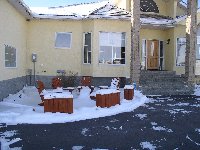
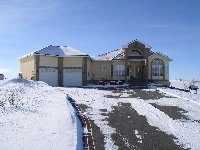
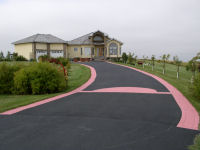
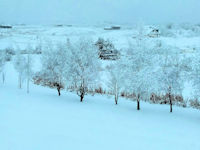
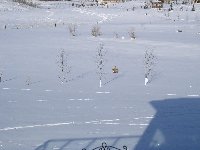
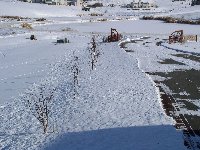
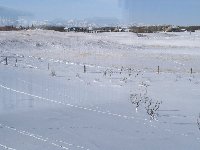

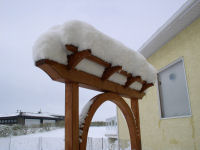
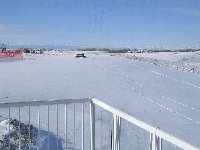
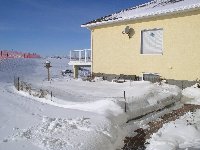
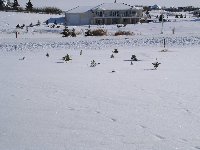
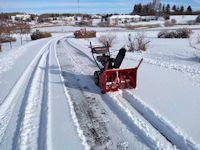
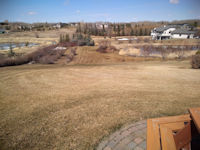
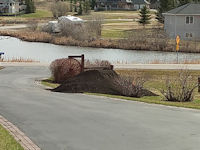
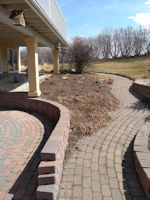
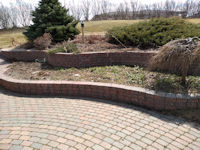
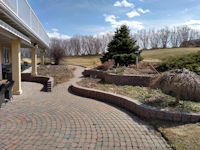
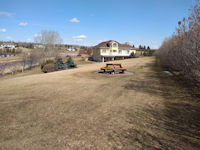
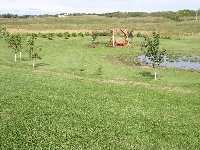

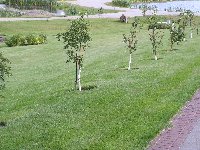
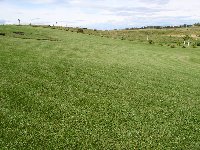
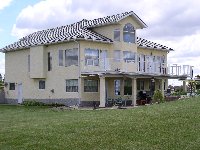
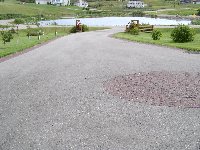
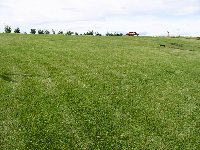
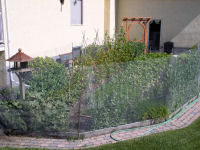

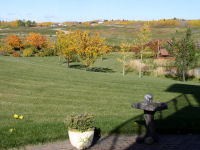
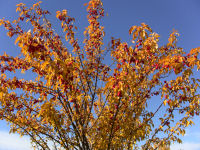
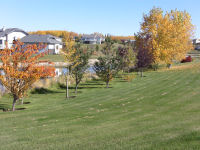
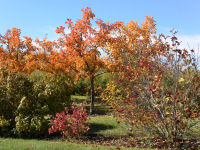
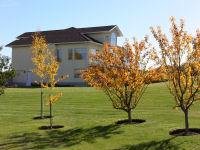
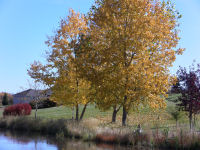
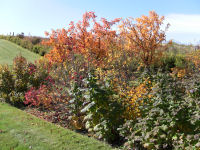
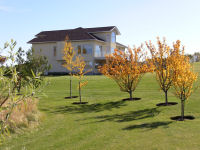
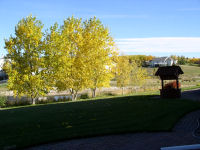
Due to the hilly terrain we have lots of ponds in our neighbourhood that are all interconnected via culverts. Over the years the water level in those ponds has risen. What used to be seasonal ponds have now become permanent ones. The neighbours across the street had to built even a dike to keep the rising water out of their basement.
Our pond is a seasonable pond. The snow accumulation from the winter and the usual large snow dump in April fills it up just in time for the geese,ducks and plovers. Even the occassional musk rat enjoys the water. Rain in June often tops up the pond and then the water level gradually lowers and by August the pond is almost dry. Our pond is the lowest point on this side of the subdivision, but it is not connected to any of the other ponds.
In spring 2004 there was a water main break at our neighbours. Due to the heavy frost and the fact that the break was at the bottom of their pond, it took quit some time for the break to be repaired. This resulted in the water eventually overflowing onto our property and topping up our pond and after that overflowing onto the farm land behind us.
This 2005 spring our pond had water, but due to the dry weather we had only a quarter left by the end of May. The other ponds however, had a very high water level at about 2" below the lowest street level. I personally suspect a leak in the water main. On May 31st it started to rain and that finally stopped on June 8th. By then the water level in the other ponds had risen so much that the lowest street level was flooded. On June 7th the water level was already that high that it started overflowing into our yard and filled up our pond. In the morning of June 8th our pond in turn started overflowing into the much lower pond on the farm behind our property.
The pictures show that at the highest water level of our pond most trees are just above the waterline. Our Pinocchio fisherman started floating and ended up on his back. Ideally the water level shoul be 6 to 12 inches lower, and that is being worked on.
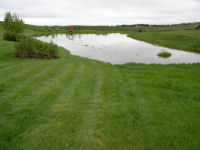
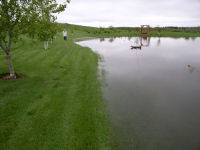
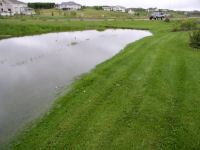
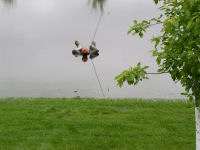
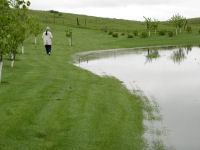
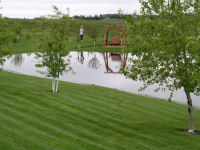
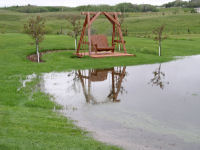
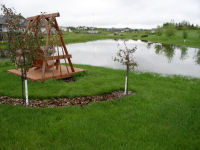
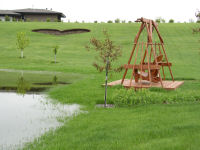
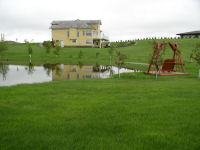
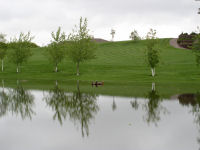
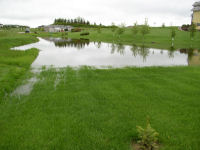
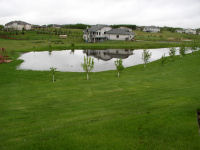
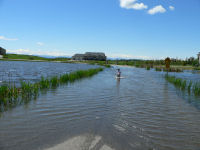
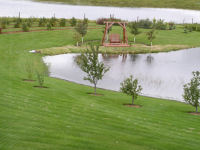
You think that this is bad? It could be worse and it did. On June 17th and 18th we got another 4" (10 cm) of rain in 24 hours. With the already saturated ground this caused major havoc throughout Southern Alberta with wide spread flooding everywhere. The neighbourhood ponds filled up more, we got more water in our pond, and there was a steady (over)flow towards the farm behind us. The line of trees along the pond where now only 3 feet away from the water edge, and a few trees next to the swing were standing in 6" (15 cm) water. The lowest spot of our street was covered with 12 to 15" (30 to 40 cm) of water, which made it tricky to navigate with ponds on both sides.
From September 9 to 11, 2005, we got yet another deluge of some 5" (12 cm) of rain. Again the street was flooded and the neighbourhood ponds overflowed into our pond. On the Last picture it can be seen that raising the land around the swing did work.
The 2013/2014 was a long cold winter with snow well into May 2014. Seeding the vegetable yard was done in the first week of June followed with more cool weather. Then some record rainfall two weeks in a row, which was actually very good. The seeds germinated very well and by early July the vegetable yard looked the best ever... until July 6th, 2014! Environment Canada had issued a Severe Thunderstorm Watch like hail, tornados and more of that good stuff. At 17:10 we had a 10 to 15 minutes heavy rain and hail storm. Hail the size up to 1 cm (3/8") covered everything in no time, and this is what it looked like in the pictures taken over a span of 3 minutes.
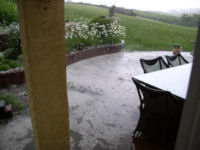
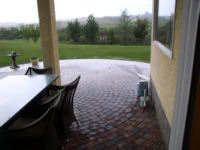
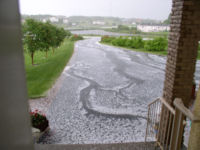
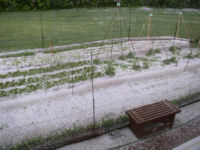
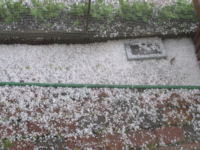
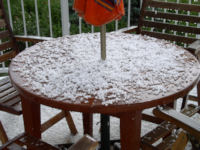
And this is what our vegetable yard looked like the next morning.
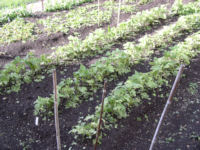
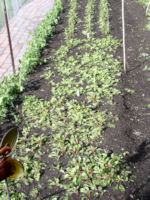
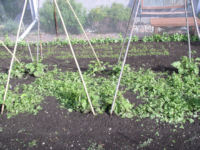
2020 was initially a wet spring and a very good growing season for the vegetable yard. That was followed with weeks of dry and warm weather. The vegetables liked that too. We ended up with 50 cm high lettuce, red beets and endive. I had everything harvested and processed to put in the freezer for the winter months. Only the slice beans were late as usual.
What are slice beans you may ask. Well, these are beans that grow on vines that curl around bamboo sticks some 2 meters height. We put vier bamboo sticks about 1 meter apart in a square and tie them together like a tepee. Those are call a shock. They bloom with red flowers that attracks bees and hummingbirds. The beans are 20 to 30 cm long, thin and about 2 cm wide. We use a special slicer mill to slice the beans diagonally. You cook them like any other vegetable.
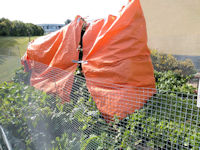
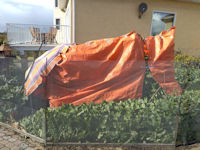
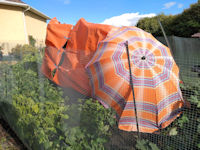
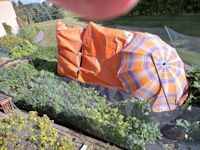
Slice beans are traditionally late in the season and cannot handle frost at all. August 2020 we had already a few occurrences of early morning night frost going down to zero or -1 degree C. I got up early before sunrise and sprayed the slice beans and regular beans with water. That makes the temparature rise a few degrees until the sun has risen.
September 7, 2020, they predicted down to -3 C over a period of five hours before sunrise. By that time I had only harvested three containers (about 10 meals) worth of slice beans. I needed a few more weeks of harvesting time. I used three tarps, an embrella and lots of duct tape to cover the four shocks. I managed to save about 75% of the slice beans vines and flowers. Thus I was able to harvest another 9 containers of slice beans, or 30 meals.
It looks like homeless shelters.
Homepage |
Grand Tour |
Main Yard Details |
Flowerbed Details |
Yard Tips |
Wildlife |
Animal Terminology |
Other Web Sites